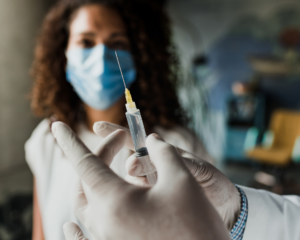The Federal Response to Covid-19 We Should Have Expected
There have been mistakes of investment, implementation, and communication, but what we’ve learned most critically is that public health is political.

Read Time: 6 minutes
Published:
The first case of Covid-19 was confirmed on the same day in South Korea and in the United States: January 20, 2020. Ten weeks later, on April 1, South Korea reported fewer than 10,000 persons had tested positive, while the Centers for Disease Control and Prevention (CDC) reported 186,000 persons testing positive in the US. Why did the disease take such different courses in the two countries? This will be the focus of historians for years to come, but let me try to lay the groundwork for that future review. With Covid, three problems in this country have aligned to work against an efficient, preventive, and life-saving response.
First, we were unprepared infrastructurally for a disease outbreak. In downsizing government, we have disinvested in public health programs generally, and more specifically in recent years in disease outbreak preparedness. Even though there were 18 new or renewed public health emergencies declared in 2017–in comparison to 29 for the prior decade–funding levels for preparedness did not increase. Indeed, public health programs constitute only 2.5% of all health spending, the remainder going to our health care and treatment system. We have ignored evidence of the life-saving, cost-effective, preventive health programs that avert diseases and prepare for disasters and emergencies. We have understaffed public health laboratories, shrunk state and local public health workforces, questioned the CDC’s budget. What do the effects of this look like? After the Ebola outbreak in 2014, there was training of first responders to infectious disease, but that training was not renewed or expanded to address other diseases and new ones like highly transmissible Covid, to which we have no immunity. The National Security Council’s global health security office, organized in 2016 after criticism of the initial response to the Ebola outbreak, was disbanded under the current administration.
Despite the warnings and “war game” simulations of a pandemic, we were also unprepared psychically for a disease outbreak. Between the New Year’s Eve announcement of a cluster of coronavirus cases in Wuhan and January 20, when the first infected American was announced, there was reporting on this international story, but little penetration of a narrative of impending crisis into cable news. We were focused on other things, the upcoming election in particular. The CDC and the national security community at the highest levels were slow to admit what was happening in the first months of 2020. Even in a public health school, Covid was not at the center of conversations until late in February; its threat did not consume my attention, let alone the nation’s. Many of the epidemiological modelers who have provided important estimates of disease spread did not devote themselves solely to Covid until February. Meanwhile, the president first suggested Covid was a hoax and later suggested it was like a common flu. Only in early March, when the stock market crashed and Italy was so starkly suffering, did we become an all-Covid-all-the-time media coverage country.
We have elected government officials who are anti-science and anti-scientist, who doubt or deny data and distrust experts. We are led by slow-to-act politicians who offer inaccurate, misleading, inconsistent, and imprecise messaging about safe behaviors and physical distancing.
Second, our governmental response was slow and halting. In South Korea, the first diagnostic test was approved within one week of the first Covid case, and public health officials started testing and quarantining immediately. Our initial response to the viral outbreak in Wuhan was merely a travel restriction for people arriving from China. South Korea tested 300,000 persons in its first two months, while we tested 60,000. Our testing difficulties were due to a series of missteps: CDC testing kit inaccuracy, lack of test reagents and components, among others. The search and prevent strategy of contact tracing and isolation, typically used when case numbers are small, was outpaced by early viral spread and the inadequate testing. As our health systems were stretched with ill patients, we witnessed a supply chain problem of personal protective equipment and ventilators. That we quickly hollowed out our strategic stockpile of medical supplies was another marker of our lack of preparation. Finally, our multiplicity of public and private health systems that lacked a single database to collate test results put us at an additional disadvantage.
Third, neither our disinvestment in health nor our slow response to this crisis was accidental. Yes, there have been federal blunders, but underlying the logistical mistakes is a philosophical position: the Republican party has as a core mission the principle of shrinking government. Since Ronald Reagan’s self-description as a small government conservative and his analysis that “government is not a solution to our problem–government is the problem,” Republicans have sought to provide less government, except for military funding. Paradoxically, with Covid, the “enemy” is invisible and so the military has been mostly sidelined. That President Trump did not use the Defensive Production Act to mobilize the full force of the country’s manufacturing base that might have relieved our undersupply of medical equipment is not a surprise. Neither is the fact that he turfed the work acquiring supplies to the states, citing the precedents of federalism and non-uniformity, while pitting governors against each other. The president’s lack of intervention, his unwillingness to organize a single, cohesive, national response when one was clearly needed offered no corrective for our unpreparedness. Coordinating neither the supply nor demand sides of equipment during a time of shortage, while asking the private sector to voluntarily act more swiftly, and leaving states to compete on the open, private market for supplies, was in keeping with the idea of a hands-off federal government. It shouldn’t be surprising that this administration has had a hard time executing a mitigation plan.
How did we let this pandemic and its consequences get so bad? We have elected government officials who are anti-science and anti-scientist, who doubt or deny data and distrust experts. We are led by slow-to-act politicians who offer inaccurate, misleading, inconsistent, and imprecise messaging about safe behaviors and physical distancing. There have been mistakes of investment, implementation, and communication, but what we’ve learned most critically is that public health is political. Because of a fixed and party-based belief that government already does too much, we have purposely not done enough, not acted urgently to help the greatest number of Americans survive a once-in-a-century crisis.
Photo by Марьян Блан | @marjanblan on Unsplash



